
* In 1943, an enterprising inventor named Frank Piasecki flew a single-seat demonstrator helicopter, the "PV-2", that proved successful enough to allow Piasecki to move on to producing helicopters for the military. Piasecki Helicopters became well-known for its tandem-rotor helicopters, starting with the "HRP" series, then the "H-21" and "HUP Retriever", and finally the unsuccessful "H-16" giant helicopter. These machines led, after Piasecki left the company, to the Boeing-Vertol Sea Knight and Chinook helicopters. This document provides a history and description of Piasecki's tandem-rotor helicopters -- as well as a series of compound helicopters developed by Piasecki in his second company. A list of illustration credits is included at the end.
* In 1940, a group of students from the engineering department of the University of Pennsylvania who were interested in helicopter design formed the "P-V Engineering Forum" to pursue development of a working helicopter. The group was led by Frank Nicholas Piasecki, the son of Polish immigrants. He had worked for Kellett Autogyro, as well as the Platt-LePage company.
After work on a "PV-1" helicopter that was abandoned before completion, the group's efforts resulted in the "PV-2", built from materials energetically scrounged up from wherever they could be found, which first flew on 11 April 1943, becoming the second workable helicopter design flown in the USA. Piasecki was the pilot, even though he had only 14 hours of flying time and no pilot's license. It was supposed to have been tethered, but it broke the line, with Piasecki setting the machine back down as quickly as he could.
The PV-2 was a single-seat helicopter of conventional main-tail rotor design, with a fabric-covered fuselage, a four-cylinder air-cooled Franklin engine with 67 kW (90 HP), and a three-blade main rotor. The main rotor blades had steel spars, with spruce glued around them; they could be folded for easy storage. The PV-2 weighed about 450 kilograms (1,000 pounds) fully loaded. However, all it could carry was a pilot; it couldn't even lift any baggage along with the pilot.
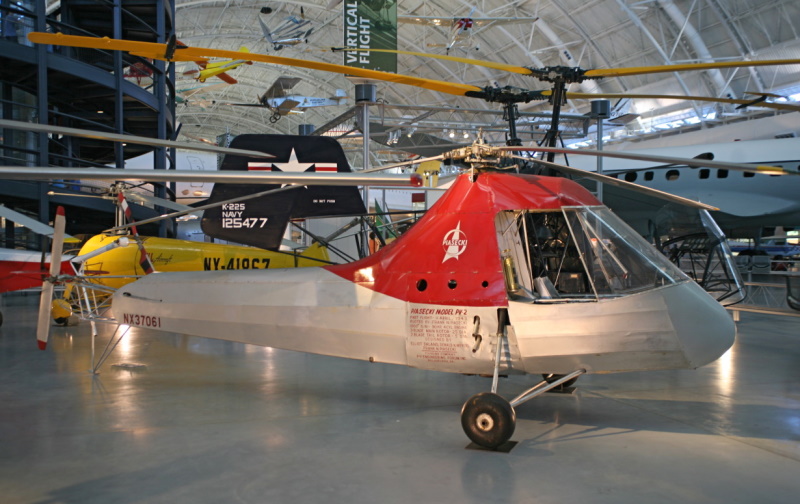
* The PV-2 was intended as a prototype for a personal helicopter, in effect a "flying car", there being a widespread perception at the time that, in the postwar period, such machines would be commonplace. That wouldn't be the case, and for the moment, the only real market for helicopters was military. The PV group began design work on a much larger military helicopter, using the agile little PV-2, backed by Piasecki's energetic salesmanship, as a sales tool.
By late 1943, it was flying better than Igor Sikorsky's competing R-4 helicopter; the US Navy was under political pressure for failing to embrace the whizzy new helicopter technology, and was suitably impressed by the PV-2. On 1 February 1944, the Navy awarded a contract to the PV group for a large helicopter for transport and search-and-rescue (SAR) duties. The result was the "PV-3", which featured a tandem-rotor configuration; this arrangement allowed a helicopter to carry a large load without too much worry about center-of-gravity issues -- and confounding Navy aeronautical officials who believed that helicopters couldn't carry large loads, even in principle.
The first PV-3, designated "XHRP-X" by the Navy and nicknamed the "Dogship", flew on 7 March 1945, being powered by a Wright / Continental R-975 Whirlwind nine-cylinder air-cooled radial engine, providing 335 kW (450 HP). The engine was mounted amidships, with drive shafts running to reduction gearboxes for each of the rotor hubs. At the time of its first flight, it was the biggest helicopter in the world -- though it was strictly a demonstrator, not close to production standard.
Two full prototypes, designated "XHRP-1", were followed by an initial batch of 10 "HRP-1 Rescuer" production helicopters, ordered by the Navy in June 1946. A second batch of 10 HRP-1s was ordered later. The first production HRP-1 flew on 15 August 1947. By that time, the company had changed names to the "Piasecki Helicopter Corporation", with Piasecki as president and chairman of the board.
The HRP-1 was powered by a Pratt & Whitney R-1340-AN-1 radial piston engine with 450 kW (600 HP). The HRP-1 could carry eight troops or 820 kilograms (1,800 pounds) of cargo. The front of the fuselage was fabric covered, while the rear was metal covered -- the prototypes originally flew without skinning, both because Piasecki was in a hurry and because it made changes easier, to then be brought up to a more refined standard. Early machines had a rounded cockpit; most production went to a flat configuration. The fuselage had a "bent" appearance to allow the rear rotor to clear the top of the front rotor, and so the HRP-1 and its direct descendants became known as the "Flying Bananas".
___________________________________________________________________
PIASECKI HRP-1:
___________________________________________________________________
rotor width:
12.5 meters (41 feet)
fuselage length:
14.38 meters (47 feet 2 inches)
height:
4.24 meters (13 feet 11 inches)
empty weight:
2,287 kilograms (5,041 pounds)
max loaded weight:
3,130 kilograms (6,900 pounds)
maximum speed:
160 KPH (100 MPH / 85 KT)
typical cruise speed:
95 KPH (60 MPH / 55 KT)
service ceiling:
3,170 meters (10,400 feet)
range:
425 kilometers (265 MI / 230 NMI)
___________________________________________________________________
The HRP-1 also had two large vertical fins attached to the tail. These had not been featured in early test flights of the PV-3, but they were added to help the rotorcraft stay straight in forward flight.
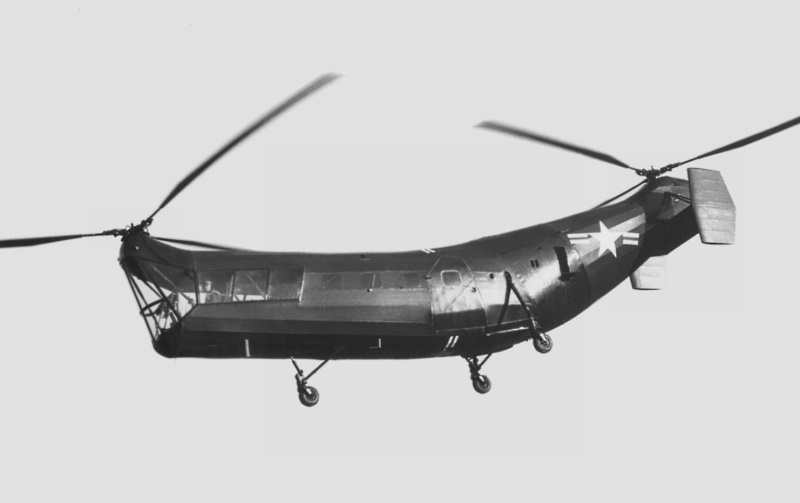
The last of the 20 HRP-1s built was delivered in 1949. 12 of them were eventually passed on to the Marine Corps for assault training, and three were handed over to the US Coast Guard as "HRP-1Gs" for SAR use. The HRP-1 was followed by the "HRP-2 (PD-17)", which was very similar but had a streamlined all-metal fuselage, with side-by-side seating for the pilot and copilot, plus improved cockpit field of view. Initial flight of the HRP-2 was on 10 November 1949, with the type going into service in 1950. The US Marines bought five for assault training.
The service HRPs were phased out in the early 1950s, with a few ending up in civilian hands. At least one has survived, ending up as a museum piece, with rumors of a few more needing restoration. The PV-2 was retained by Piasecki for ceremonial flights up to 1965, when it was donated to the Smithsonian National Air & Space Museum in Chantilly VA, where it remains on display.
BACK_TO_TOP* In response to a US Air Force (USAF) requirement, Piasecki then took the PD-17 design and scaled it up to produce the "XH-21 (PD-22)", this machine being the definitive "flying banana". The XH-21 prototype initially flew on 11 April 1952, and led to a USAF order for 18 "YH-21" evaluation rotorcraft.
The Air Force was pleased with the YH-21, and ordered 32 full production machines, designated the "H-21 / H-21A Workhorse". The H-21A was fitted with a Wright R-1820-103 Cyclone nine-cylinder radial engine, derated to 855 kW (1,150 HP). It had a crew of two and could carry 14 passengers or 12 stretchers. The H-21A was optimized for cold-weather operation, being used for SAR and support on the USAF's far-north Distant Early Warning (DEW) radar picket line. Six more were supplied to Canada under the US Military Assistance Program (MAP).
The follow-on "H-21B" assault transport featured the same engine fit, but with the full 1,065 kW (1,425 HP) available for lift, along with extended rotor blades, allowing the H-21B to carry 20 troops. It also had some armor, an autopilot, and the ability to be fitted with two external fuel tanks. 163 H-21Bs were built for the USAF, being used for logistics support duties and, in a slightly modified version designated the "SH-21B", for SAR operations.
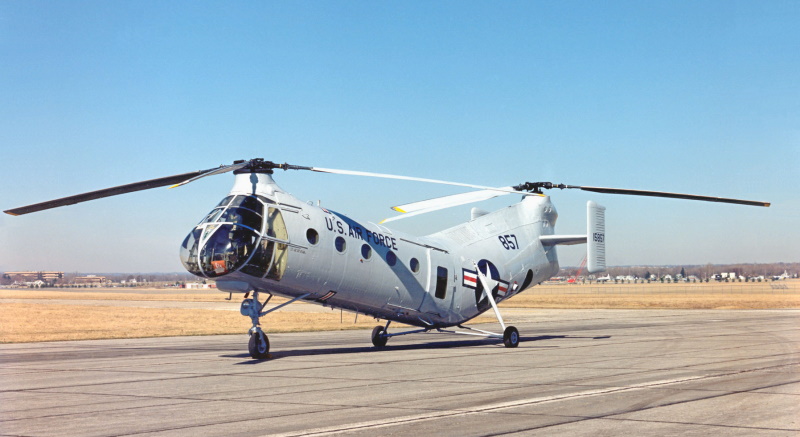
The main production version was the "H-21C", which the US Army bought as the "Shawnee", and used for troop and cargo transport. It was much like the H-21B, but featured a larger troop capacity, plus a belly sling hook that could carry 1,800 kilograms (4,000 pounds). The H-21C first flew in the spring of 1954, with the Army obtaining 188; some sources claim the Army also inherited some H-21Bs from the Air Force, and brought them up to H-21C standard.
___________________________________________________________________
PIASECKI H-21C SHAWNEE:
___________________________________________________________________
rotor width:
13.41 meters (44 feet)
fuselage length:
16 meters (52 feet 6 inches)
empty weight:
3,629 kilograms (8,000 pounds)
max loaded weight:
5,215 kilograms (11,500 pounds)
cruising speed:
160 KPH (100 MPH / 85 KT)
service ceiling:
5,180 meters (1,600 feet)
range:
800 kilometers (500 MI / 435 NMI)
___________________________________________________________________
The Shawnee was the workhorse of the early Vietnam War, from December 1961 to late 1963, when the Bell UH-1 "Huey" arrived. Although an H-21C was evaluated as a gunship, armed with machine guns and unguided rocket pods, the Shawnee was never particularly well suited to operations where it might be shot at, since its electrical and hydraulic systems were easily damaged; Army troops referred to the Shawnee as "an accident waiting for a place to happen", and one was reputedly put out of action by a spear. Having been designed for cold-weather operation, it was also underpowered in "hot and high" climates. Large piston-powered helicopters were something of a dead end.
The US Marines flew a few H-21As and an H-21B for evaluations, but never adopted the Shawnee for service. The French Army obtained a total of 98 H-21Cs, while the French Navy obtained 10; Canada obtained six, while the West German Army bought 32. The French machines saw service in the Algerian War, with some of them armed with pintle-mounted machine guns for defense.
* Following a reorganization in March 1956, Piasecki Helicopters became the "Vertol (Vertical Take-Off & Landing)" company. The H-21A/B was given the new company designation of "Vertol 42", while the H-21C became the "Vertol 43".
The company developed a refinement of the H-21 design with the designation of "Vertol 44", which featured all-metal rotor blades and automatic stabilization equipment. Nine Vertol 44s were bought by the Swedish Navy as "HKP-1s", while the Japanese Ground Self-Defense Force bought two, and the Canadians bought three.
Two H-21Cs were fitted with General Electric T58 turboshafts, being designated as "Model 71 / H-21D", while two others were fitted with Avco Lycoming T53s -- the T53-powered version leading to the next-generation "Vertol 107", which incorporated design lessons obtained by Piasecki techs working with French forces in Algeria. The Vertol 107 would go into production as the "Sea Knight" after Vertol had been absorbed into Boeing in 1960. A scaled-up version of the Vertol 107, the "Vertol 114", would become the legendary "Chinook".
When the US military revised and consolidated their aircraft designation schemes in 1962, the H-21 designations were updated as follows:
Vertol promoted a commercial version of the H-21, the "Model 44"; it appears a few were sold, but details are unclear. The last H-21s were retired in 1967. A good number of them survive as static displays, with one still in flightworthy condition.
BACK_TO_TOP* In 1945, the US Navy issued a request for a helicopter that could act as an "aircraft guard", to recover pilots who went into the sea during carrier air operations, as well as perform SAR or utility transport duties. Piasecki modified their tandem-rotor concept, replacing the banana-shaped fuselage with a straight fuselage mounting a pedestal on the tail for the tail rotor. That allowed the rotors to be spaced more closely together, giving the helicopter a smaller "footprint" for shipboard use. The result was the "PD-14", with a prototype flown under the Navy designation "XHJP-1", this machine being powered by a single Wright / Continental R-975-34 Whirlwind nine-cylinder air-cooled radial engine with a take-off power of 370 kW (525 HP), driving three-bladed rotors fore and aft. Initial flight was in March 1948.
The Navy liked the design, and ordered three pre-production "HUP-1 Retrievers (PV-18)", which were much like the initial prototype -- except that angled endplate fins were added to the rear rotor pylon, to keep the helicopter going straight in forward flight. The Retriever went into US Navy service in early 1951.
The Retriever had a three-man crew, and could accommodate up to five passengers or three casualty litters. The Retriever had a rectangular hatch in the belly, for a winch with a lift capacity of 180 kilograms (400 pounds). The helicopter's rotors could be folded for shipboard storage. The Navy ordered an additional 22 HUP-1s, which were delivered in the 1950:52 timeframe. They operated as an air guard in carrier operations during the Korean War.
___________________________________________________________________
PIASECKI HUP-1 RETRIEVER:
___________________________________________________________________
rotor width:
10.67 meters (35 feet)
fuselage length:
9.75 meters (32 feet)
height:
4.01 meters (13 feet 2 inches)
empty weight:
1,798 kilograms (3,965 pounds)
max loaded weight:
2,600 kilograms (5,735 pounds)
cruise speed:
130 KPH (80 MPH / 70 KT)
service ceiling:
3,660 meters (12,000 feet)
range:
570 kilometers (355 MI / 310 NMI)
___________________________________________________________________
It appears the Whirlwind engine was troublesome; the original Wright version was reliable, but Continental's tinkerings with it were not entirely for the better. Problems were reduced when Piasecki lowered the maximum take-off weight limit by 450 kilograms (1,000 pounds) and derated the engine by 75 kW (100 HP).
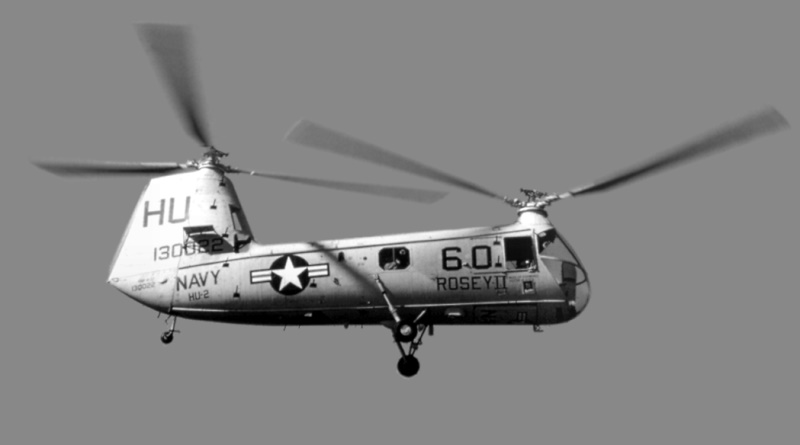
The HUP-1 was followed in production by the "HUP-2", which had an uprated Continental R-975-42 engine with 410 kW (550 HP) and a Sperry autopilot, which allowed the tail fins to be deleted. Ironically, the autopilot would lead to accidents in service, and so it would be disabled. A total of 166 HUP-2s was built for the US Navy, and 15 were supplied to the French Navy as well. The US Navy also obtained 12 Retrievers fitted with dipping sonar for antisubmarine warfare, these machines being designated "HUP-2S"; and one HUP-2 was experimentally fitted with floats.
The US Army obtained 70 Retrievers, but with an improved R-975-46A engine, power-boosted controls, reinforced floor, and larger cargo door. These machines were designated the "H-25A Army Mule"; they were used as utility transports. The Navy obtained 50 for use in cargo transport and air-ambulance duties, with three of this quantity going to Canada. There is some confusion in records, with claims that the Army didn't find the H-25A very satisfactory and transferred most of them to the Navy as HUP-3s, with the Army survivors used for training.
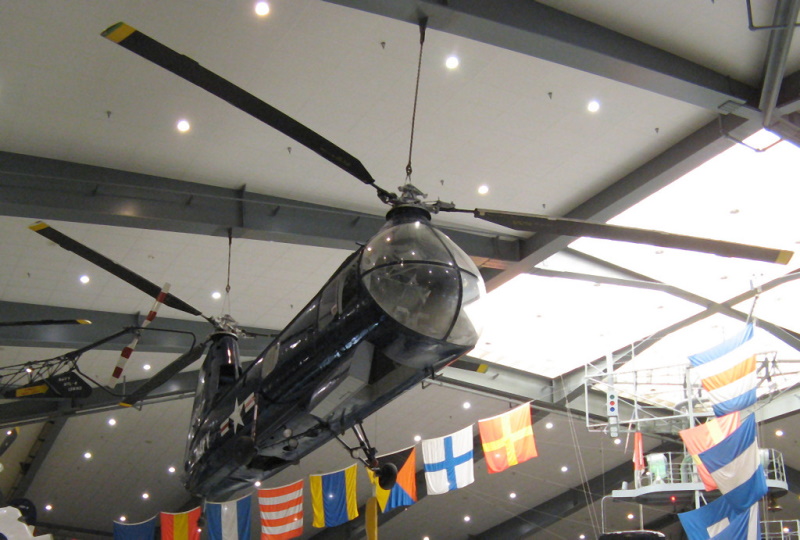
A total of 339 HUP Retrievers was built in all, the last being delivered in July 1954. There was work on a much-improved "HUP-4", with a Wright R-1300 radial providing 520 kw (700 HP), but the Navy preferred the Kaman Seasprite. In 1962, with the US adoption of a standard aircraft designation scheme, the HUP-2s still in service became "UH-25Bs", and HUP-3s became "UH-25Cs". The last US Retrievers were phased out in 1964, with the last French Retrievers retired in 1965. A number of Retrievers survive on static display, but it doesn't appear any of them remain flightworthy.
BACK_TO_TOP* The "H-16 Transporter (PV-15)", with the same general tandem-rotor configuration as the Retriever but greatly scaled up, was developed in response to an Air Force requirement for a long-range SAR helicopter to pick up downed Strategic Air Command bomber crews. Design studies began in 1946, leading to a contract for two prototypes in 1949.
The initial Transporter prototype, the "YH-16", first flew on 23 October 1953. At the time, it was the biggest helicopter in the world, one observer saying it was like watching an "ocean liner" take to the air. It was powered by two Pratt & Whitney (PW) R-2180 Twin Hornet 14-cylinder, two-row, air-cooled radial engines with 1,230 kW (1,650 HP) each, powering three-bladed rotors fore and aft, the blades being made of aluminum honeycomb with aluminum skinning. There was some experimenting with tailfin configurations in the course of trials to keep the machine flying straight, but they were ultimately discarded.
The Transporter could be fitted with internal auxiliary fuel tanks to give it extended range for the SAR role. Although it wasn't the basis of the original Air Force requirement, Piasecki engineers had designed it to operate as a heavy-lift transport helicopter, with a tail loading ramp, capable of handing 40 troops, three small trucks, or other loads. That attracted the US Army, which joined the Air Force in the program. The YH-16 having proven underpowered, the second prototype, the "YH-16A (PV-45)", was fitted with twin Allison YT38 turboshaft engines instead, providing 1,340 kW (1,800 SHP) each. Initial flight was in July 1955, with Harold Peterson and George Callahan in the cockpit.
___________________________________________________________________
PIASECKI YH-16A TRANSPORTER:
___________________________________________________________________
rotor width:
25 meters (82 feet)
fuselage length:
23.65 meters (77 feet 7 inches)
height:
7.62 meters (25 feet)
empty weight:
11,545 kilograms (25,450 pounds)
max loaded weight:
20,730 kilograms (45,700 pounds)
cruise speed:
200 KPH (155 MPH / 135 KT)
service ceiling:
4,755 meters (15,600 feet)
range:
350 kilometers (215 MI / 190 NMI)
___________________________________________________________________
The YH-16A later set a world speed record. Unfortunately, it crashed on 5 January 1956 after the rear rotor shaft failed, with both Peterson and Callahan being killed. Although the first prototype was being upgraded at the time to the "YH-16B Turbo-Transporter" specification, with twin Allison T56 engines providing 1,565 kW (2,100 SHP) each and a maximum passenger load of 69, the program was abandoned and the update was not completed.
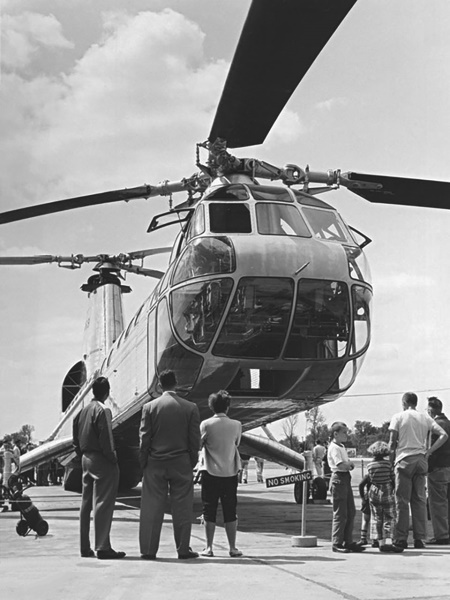
There were also plans to fit tall stilt landing gear to the machine to allow it to straddle and carry under-body pods that could be fitted as field operating rooms, communications centers, or repair facilities, but that didn't happen either. That was just as well, since the same concept was implemented with the later Sikorsky S-64 Skycrane, and proved a nonstarter.
BACK_TO_TOP* Frank Piasecki was no longer with the company he had founded in the 1940s by the time of the crash of the YH-16A Transporter. He was an energetic entrepreneur but not a very good manager, tending to emphasize enthusiasm over process, and inclined to sweatshop labor practices -- he worked all the time, why shouldn't everyone else? In May 1955, due to a disagreement with the board of directors, he was forced to leave the company, with the company name change to Vertol the next year.
He started over, setting up the "Piasecki Aircraft Company (PIAC)". PIAC explored unusual niches in vertical take-off design, such as the well-known but unsuccessful "flying jeeps" of the 1950s; it was basically a family firm, several of Frank's kids becoming staff, Frank wanting nothing more to do with running a big company. It seems he decided it wasn't any fun.
In the late 1950s, PIAC began work on an experimental compound helicopter demonstrator named the "16H-1 Pathfinder". It performed its first flight on 21 February 1962 -- though on its initial flight it was a crude "lash-up", being gradually brought up to a respectable configuration through the course of trials. In its complete state, the Pathfinder weighed 725 kilograms (1,600 pounds) featured a "ring tail", a ducted pusher propeller with vanes in the exhaust duct for thrust vectoring and torque cancellation; as well as short wings, capable of being folded for handling, to unload the rotor and reduce asymmetry of lift, permitting higher speeds.
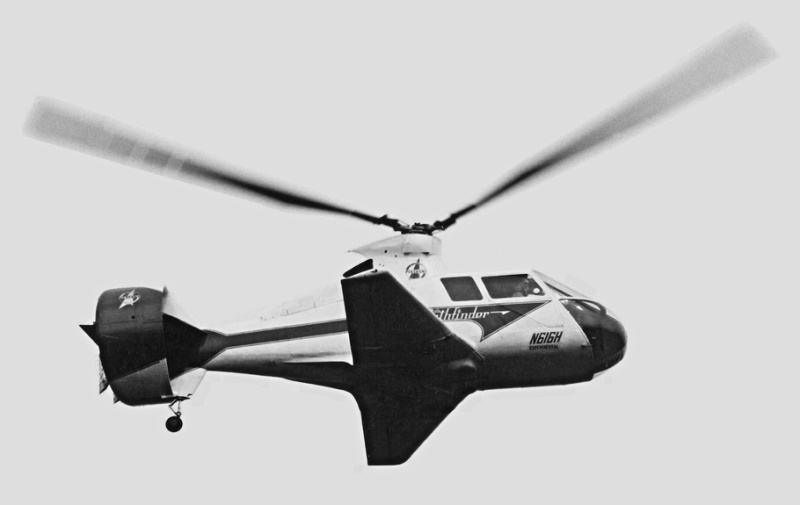
The Pathfinder was powered by a Pratt & Whitney Canada (PWC) PT6B-2 turboshaft engine providing 410 kW (550 SHP), driving a three-bladed rotor with a diameter of 12.5 meters (41 feet) and the pusher propeller. The 16H-1 had a fuselage length of 7.62 meters ( 25 feet) and had retractable landing gear; it could carry a pilot and up to four passengers.
In 1965, under a joint Army-Navy contract, PIAC flew the stretched "16H-1A Pathfinder II", rebuilt from the 16H. The 16H-1A had seating for six passengers, a bigger rotor, and a General Electric T58-GE-8 turboshaft providing 930 kW (1,250 SHP). In 1966, the Pathfinder II was modified to "16H-1C" configuration, with an uprated T58 engine providing 1,120 kW (1,500 SHP).
___________________________________________________________________
PIAC 16H-1A PATHFINDER II:
___________________________________________________________________
rotor width:
13.4 meters (44 feet)
fuselage length:
11.4 meters (37 feet 11 inches)
wingspan:
10 meters (32 feet 10 inches)
height:
3.45 meters (11 feet 4 inches)
empty weight:
2,165 kilograms (4,800 pounds)
loaded weight:
4,870 kilograms (10,800 pounds)
max speed:
370 KPH (230 MPH / 200 KT)
cruise speed:
280 KPH (175 MPH / 150 KT)
service ceiling:
5,700 meters (18,700 feet)
range:
1,530 kilometers (950 MI / 825 NMI)
___________________________________________________________________
Piasecki came up with various concepts to follow the 16H-1A, such as the "16H-3", which was further stretched for nine seats, and was powered by twin PWC PT6B-30 turboshafts. It didn't happen, but the company continued to investigate the ring tail concept, which formally became the "vectored thrust ducted propeller (VTDP)".
The company proposed fitting the VTDP to Bell AH-1 Cobra and Boeing AH-64 Apache helicopter gunships during the 1990s; some sources claim they were actually flown, but that appears to be an error. In late 2000, the US Navy awarded a contract to PIAC to fit a ring tail to a Sikorsky YSH-60F Seahawk helicopter, with the program passed over to the Army in 2003. Initial flight of the "X-49A Speedhawk" was on 29 June 2007.
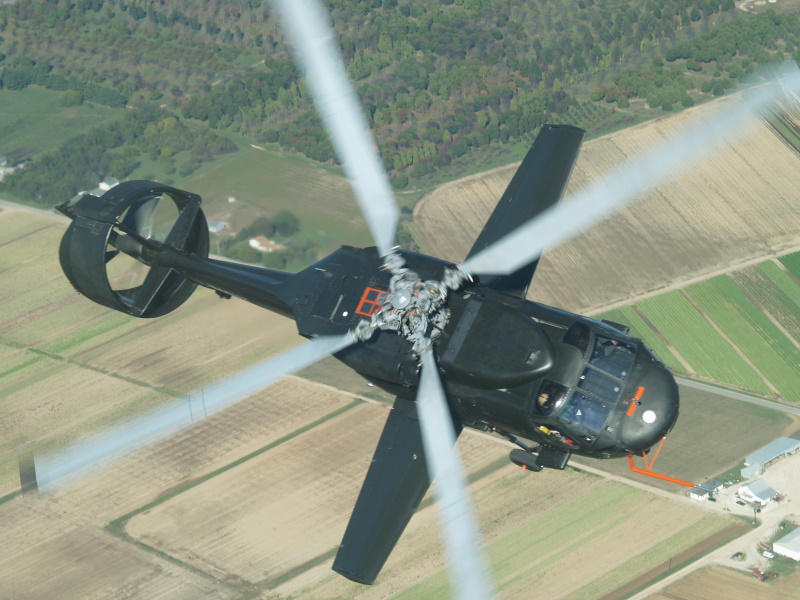
The Speedhawk featured a set of wings, obtained from a business jet, and the VTDP. It was almost 50% faster than a Seahawk in level flight -- it was clocked at over 320 KPH (200 MPH) -- despite the fact that it had the same engines, though it did require about 10% more power for hovers, due to the masking effects of the wings. The Speedhawk was strictly a demonstrator, and there were no plans to go to a production machine.
BACK_TO_TOP* One of the particularly unorthodox aircraft concepts investigated by PIAC was the "PA-97 Heli-Stat", was a demonstrator for a helicopter-airship flying crane -- involving the gas envelope from a retired US Navy ZPG-2W blimp, riding on a frame on which four Sikorsky S-58 Choctaw helicopters, less their tail rotors, were mounted. It was built in response to a contract from the US Forest Service, the Navy apparently acting as an agent in awarding and administering the contract.
The first test flight of the PA-97 was on 26 April 1986, from the US Navy station at Lakehurst, New Jersey, where there were airship hangars for supporting the program. On 1 July 1986, vibrations set up by a wind gust caused the PA-97 to break apart, with the four S-58 helicopters falling from the frame, one of the pilots being killed, three others being seriously injured. The ghastly event was captured on film. That was the end of the program.
It is somewhat surprising that PIAC survived the disaster, since the PA-97 was a such a ramshackle-looking contraption, the fatal accident then reflecting badly on the firm's competence. There have been further schemes by other companies to build heavy lifters along such lines, if more credible in appearance; however, so far, none of them have resulted in a production machine.
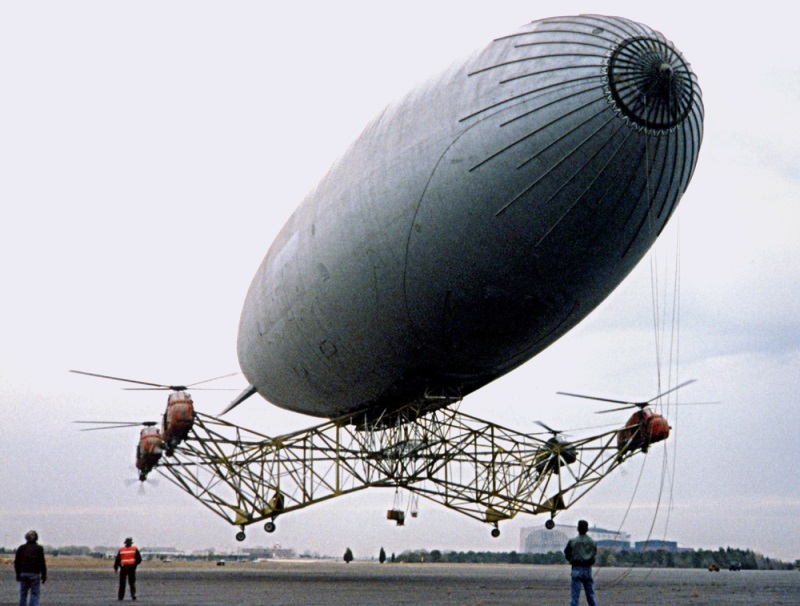
The Piasecki helicopters are not well-documented, and there are considerable uncertainties in the historical record -- particularly for production quantities. For the HUP, for example, sources claim that 339 were built, but it is very difficult to get quantities for each variant that add up to that sum.
* Sources include:
Wikipedia and other online sources were scavenged for what details I could find.
* Illustrations details:
* Revision history:
v1.0.0 / 01 nov 15 v1.0.1 / 01 oct 17 / Review & polish. v1.0.2 / 01 sep 19 / Review & polish. v1.0.3 / 01 jul 21 / Review & polish. v1.0.4 / 01 oct 21 / Review & polish. v1.0.5 / 01 sep 23 / Review & polish.BACK_TO_TOP
